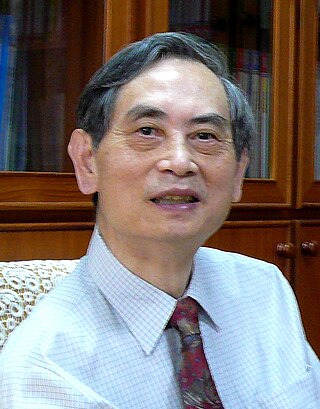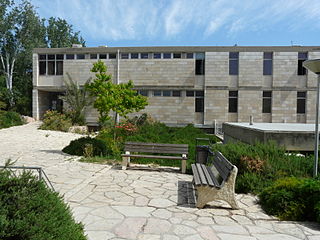Related Research Articles

Condensed matter physics is the field of physics that deals with the macroscopic and microscopic physical properties of matter, especially the solid and liquid phases, that arise from electromagnetic forces between atoms and electrons. More generally, the subject deals with condensed phases of matter: systems of many constituents with strong interactions among them. More exotic condensed phases include the superconducting phase exhibited by certain materials at extremely low cryogenic temperatures, the ferromagnetic and antiferromagnetic phases of spins on crystal lattices of atoms, the Bose–Einstein condensates found in ultracold atomic systems, and liquid crystals. Condensed matter physicists seek to understand the behavior of these phases by experiments to measure various material properties, and by applying the physical laws of quantum mechanics, electromagnetism, statistical mechanics, and other physics theories to develop mathematical models and predict the properties of extremely large groups of atoms.

Frank Anthony Wilczek is an American theoretical physicist, mathematician and Nobel laureate. He is the Herman Feshbach Professor of Physics at the Massachusetts Institute of Technology (MIT), Founding Director of T. D. Lee Institute and Chief Scientist at the Wilczek Quantum Center, Shanghai Jiao Tong University (SJTU), distinguished professor at Arizona State University (ASU) and full professor at Stockholm University.

Brian David Josephson is a British theoretical physicist and professor emeritus of physics at the University of Cambridge. Best known for his pioneering work on superconductivity and quantum tunnelling, he was awarded the Nobel Prize in Physics in 1973 for his prediction of the Josephson effect, made in 1962 when he was a 22-year-old PhD student at Cambridge University. Josephson is the first Welshman to have won a Nobel Prize in Physics. He shared the prize with physicists Leo Esaki and Ivar Giaever, who jointly received half the award for their own work on quantum tunnelling.
The Tom W. Bonner Prize in Nuclear Physics is an annual prize awarded by the American Physical Society's Division of Nuclear Physics. Established in 1964, and currently consisting of $10,000 and a certificate, the Bonner Prize was founded in memory of physicist Tom W. Bonner. The aim of the prize, as stated by the American Physical Society is:
Philippe Pierre Gaston François Nozières was a French physicist working at Institut Laue-Langevin in Grenoble, France.
The Nevill Mott Medal and Prize is an award presented in selected years by the Institute of Physics in the United Kingdom, for distinguished research in condensed matter or materials physics. It was first established in 1997 thanks to a donation from Sir Nevill Mott's family. Sir Nevill Mott was one of the outstanding British condensed matter theorists and won a Nobel Prize in Physics in 1977. He died in 1996. The award consists of a silver medal and a prize of £1000.
Wick C. Haxton is an American theoretical nuclear physicist and astrophysicist. He is a professor of physics at the University of California, Berkeley and senior faculty scientist at Lawrence Berkeley National Laboratory. He was appointed a co-editor of the journal Annual Review of Nuclear and Particle Science as of 2023. In 2024, he was elected to the American Philosophical Society.
Francesco Iachello is an Italian nuclear engineer and theoretical physicist, who works mainly on nuclear and molecular physics. He and his collaborator Akito Arima are the creators of the "interacting boson model".

Sow-Hsin Chen, was a Hoklo Taiwanese physicist and Professor Emeritus at Massachusetts Institute of Technology (MIT). He was a recognized pioneer in the research of the dynamic properties of supercooled and interfacial water with the use of neutron scattering techniques. As an educator, he was recognized for his training of young scientists in the use of those same techniques. Regarding hydrogen storage, his research focused on the use of activated carbon to allow hydrogen to be stored at room temperature.

The Racah Institute of Physics is an institute at the Hebrew University of Jerusalem, part of the faculty of Mathematics and Natural Sciences on the Edmund J. Safra Campus in the Givat Ram neighborhood of Jerusalem.
Dieter Vollhardt is a German physicist and Professor of Theoretical Physics at the University of Augsburg.
Michael David Fayer is an American chemical physicist. He is the David Mulvane Ehrsam and Edward Curtis Franklin Professor of Chemistry at Stanford University.
Mohit Randeria is a US-based Indian condensed matter physicist and a professor of physics at Ohio State University. Known for his research on condensed matter theory and superconductivity, Randeria is an elected fellow of the American Physics Society. The Council of Scientific and Industrial Research, the apex agency of the Government of India for scientific research, awarded him the Shanti Swarup Bhatnagar Prize for Science and Technology, one of the highest Indian science awards, for his contributions to physical sciences in 2002. He was awarded the 2002 ICTP Prize of the International Center for Theoretical Physics, Trieste and the 2022 John Bardeen Prize.
Talat Shahnaz Rahman is a Pakistani condensed matter physicist whose research topics include surface phenomena and excited media, including catalysis, vibrational dynamics, and magnetic excitations. She has also helped develop molecules that can "walk" across a solid surface by moving one part of the molecule while keeping another part attached to the surface. She is UCF Pegasus Professor of Physics at the University of Central Florida.
John Dirk Walecka, often quoted as J. Dirk Walecka is an American theoretical nuclear and particle physicist. He is a fellow of the American Physical Society and the author of numerous textbooks in physics. Walecka is currently the Governor's Distinguished CEBAF Professor of Physics, Emeritus at the College of William and Mary.

Stefano Fantoni is an Italian theoretical physicist, now retired from the International School for Advanced Studies in Trieste (SISSA), still working in the fields of nuclear physics and low temperature physics.
William P. Halperin is a Canadian-American physicist, academic, and researcher. He is the Orrington Lunt Professor of Physics at Northwestern University.
David Maurice Brink was an Australian-British nuclear physicist. He is known for the Axel-Brink hypothesis.
Gene Frederick Dresselhaus was an American condensed matter physicist. He is known as a pioneer of spintronics and for his 1955 discovery of the eponymous Dresselhaus effect.
References
- 1 2 Home Page of George F. Bertsch - Institute for Nuclear Theory
- ↑ "George Bertsch | Array of Contemporary Physicists". Archived from the original on 2014-10-20. Retrieved 2016-04-19.
- ↑ Achim Richter Replaces George Bertsch as Editor of Reviews in Modern Physics, APS News, December 2005
- ↑ George Bertsch, 2004 Tom W. Bonner Prize in Nuclear Physics Recipient
- ↑ Becker, Richard L. (1974). "Review of The Practitioner's Shell Model by George F. Bertsch". Physics Today. 27 (11): 63–64. Bibcode:1974PhT....27k..63B. doi:10.1063/1.3128995.